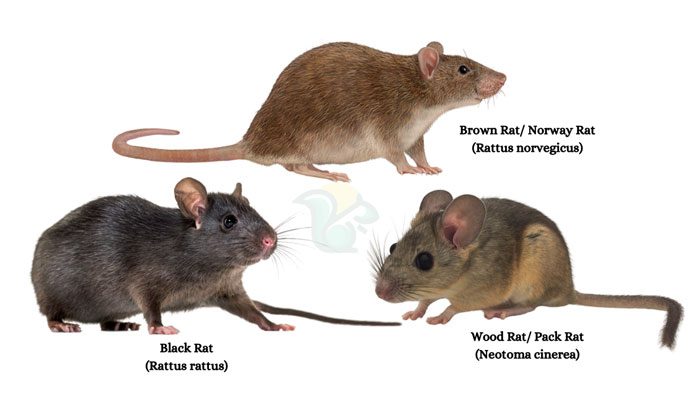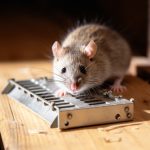3 Types of Rats In Alaska: Ins and Outs About These Invasive Rodents
Alaska has been fighting invasive rat issues since 1780, when the first non-native rat sailed to the state. Due to the abundance of prey and no fewer predators, rats grew in dense populations within a very short time.
So, how many types of rats are in Alaska? There are basically three types of invasive rats found in Alaska. They are as follows.
- Brown Rat/ Norway Rat (Rattus norvegicus),
- Black Rat (Rattus rattus),
- The Woodrat/ packrat (Neotoma cinerea).
Further, we have discussed the whole picture of rats in Alaska: their residents, food habits, identification, etc. Also, we have attached a quick table containing the characteristics of these rats as a bonus for the readers.
3 Invasive Rats in Alaska: Everything You Need to Know
Three major rat species in Alaska have been quite invasive and acted adversely towards the ecosystem. The Brown Rat/ Norway Rat (Rattus norvegicus), Black Rat/ Roof rat (Rattus rattus), Woodrat/ packrat (Neotoma cinerea) are the most prominent ones.

A few exceptions, Kenai Peninsula, Anchorage, Prince William Sound, the Alaska Peninsula, western Alaska, and the interior, are considered to be rat-free cities. These rats have been documented in Dutch Harbor, Sitka, Craig, Juneau, Adak, Wrangell, and the Aleutians.
The following segment attaches a detailed overview of these rats; take a look.
The Brown Rat/ Norway Rat (Rattus norvegicus)
The brown rat is also known as the Common rat, Norway rat, wharf rat, Hanover, or Norwegian rat. It is one of the most common and aggressive rat species in Alaska.
- Identification: These rats can be 10 inches long and may weigh 140 g to 500 g. Male rats are relatively larger than female rats. They feature coarse brownish or black/ white splotched fur. Pet rats may have black, white, or brown hairs. The hairless ears and tail are shorter than other rats.

Often, these rats can be confused with Black rats. But Norway Rats’ temporal ridge (sides and the base of the skull) are straight.
- Habitat and Nesting: The Norway rats originated from Northern China and later sailed to almost every part of the world. No port city is free from these rats.
They are most populated around human locations. These rats can be seen everywhere, be it sewers, basements, open fields, or garbage baskets.
- Food Habit: Though they are omnivorous, they mostly prefer a carnivorous diet. Their diet includes snails, pigeons, rabbits, shrimp, mussels, young amphibians, poultry, carrion, and seabirds in Alaska. They also feed on seeds and human foods.
- Behavior: The Norway rats are extremely adaptive to their surrounding environment. Though they are not great at climbing, they are good swimmers. They can be active both day and night.
- Reproduction: These rats can produce 14 litters every year.
- Average Life Span: In the wild, 2 years; in captivity, 4 years.
Black Rat (Rattus rattus)
Black rats are known as Roof rats, House rats, or Ship rats. They are considered destructive due to contamination abilities.
- Identification: The most distinctive feature of Black Rats is the larger ears, eyes, and tail. The tail, when curved, can reach to the nose. They are covered in black, brown, agouti, or gray fur. They can be 7 to 9 inches long and weigh around 70 to 300 g. The temporal ridge of these rats is slightly curved.
- Habitat and Nesting: Black rats are not native to North America, but they can be sighted in coastal areas, Southern America, Arizona, Phoenix, and Alaska.

They mainly live in tropical environments and elevated areas like roofs, trees, and farms.
- Food Habit: These cats are omnivorous (98% plants and 2% arthropods). They live on seeds, vegetables, nuts, insects, and so on.
- Behavior: They are nocturnal, live in packs, and are aggressive if they feel threatened. These rats are not good swimmers, though they are excellent climbers.
- Reproduction: Up to 5 litters per year.
- Average Life Span: In the wild, 1 year; in captivity, 4 years.
Wood Rat/ Pack Rat(Neotoma cinerea)
The Wood rat with its bushy tails is known as Pack Rat/ Packrat, a common and widely spread species in the USA.
- Identification: Bushy-tailed woodrats are the largest in the genus and can be up to 15 inches long with 11 ounces of body weight. It features protruding eyes, full and long whiskers, a tail like a squirrel (fuller and flat), and larger hairless ears.
It is a bi-coloured rat with gray/ black/ dark brown fur on the outside and the back. The feet, ears, and belly are white, buff or pinkish.
- Habitat And Nesting: These rats are found in Arizona Yukun south to northern New Mexico and Alaska. They are often seen in hollow trees, caves, rocky slopes, and deserted buildings.

They create their middens (nesting) by gathering rocks, bones, sticks, rocks, feathers, and other objects. These middens can be quite large as these rats make them through generations. By urinating, they stick these objects together and make a safe nest.
- Food Habit: Woodrats are primarily vegetarian and live on shrubs, conifer, fungi, fruits, and seeds.
- Behavior: They are nocturnal, shy, and great climbers.
- Reproduction: It may produce 1 to 4 litters per year.
- Average Lifespan: In the wild, 3 years, and in captivity, over 6 years.
Here is a summary of all three rats found in Alaska.
| Characteristics | The Brown Rat/ Norway Rat (Rattus norvegicus) | Black Rat (Rattus rattus) | Wood Rat/ Pack Rat(Neotoma cinerea) |
|---|---|---|---|
| Length | 10 inches | 7 to 9 inches | 15 inches |
| Weight | 140 to 500 g | 70 to 300 g | 311.844g |
| Distinctive Feature | Shorter ear and tail, straight temporal ridge | Larger eyes, ears, and tail, curved temporal ridge | Bushy tail, large ears |
| Life span | In the wild: 2 years | In the wild: 1 year | In the wild: 3 years |
| In Captivity: 4 years | In Captivity: 4 years | In Captivity: over 6 years | |
| Color | Coarse brownish, black, white | Clack, brown, agouti, gray | Bi-color gray/ black/ dark brown and white/ pinkish or buff |
| Mammary glands (in pairs) | 6 | 5 | 2 |
| Reproduction | 14 litters per year | 5 litters per year | 1 to 4 litters per year |
| Food Habit | Omnivorous | Omnivorous but mostly plant-based | Vegetarian |
| Habitat | Almost every port city | Coastal areas, Southern America, Arizona, Phoenix, and Alaska | Arizona, Yukun south to northern New Mexico and Alaska |
| Nesting | Anywhere around humans | Elevated areas | Creates middens by gathering sticks, papers, bones, rocks, etc. |
| Disease Transmission | Diseases: typhus, trichinosis, bubonic plague, Weil’s disease, toxoplasmosis, etc. Contaminates through Saliva, urine, feces, mites, and ticks. | Carrie’s zoonotic pathogens cause NTDs. Other transmitted diseases are salmonellosis, lymphocytic choriomeningitis,Murine typhus, plague, and oriental rat flea to pets. | Lyme disease and anaplasmosis. |
How to Prevent Rat Infestation in Alaska?
Rat infestation prevention in Alaska has been a primary concern for many years. However, the following proceedings can be performed to reduce the rat infestation.

Prevention
- The state government has forbidden intentional and unknown harbor of rats and mice in ships and vessels that come to Alaska. Also keeping rats as pets are also banned; feeding them is also prohibited. So, follow the law.
- Entry points of both the ships and houses should be sealed so that no rats can get shelter. Also, the burrows of the Norway rats should be bolted.
- Clutter should be minimized; rats take shelter in clutters.
- Make sure to seal the garbage box; rats often eat from the garbage box.
Control
- Some natural predators like cats, weasels, and birds of prey should be released.
- Set traps where the rats are mostly populated. Snap traps, plywood boxes or tubes, barrels, glue boards, and electric shock traps can be set.
Eradication
- Widespread use of rat poison can effectively eradicate rats. But it can have side effects on the environment; hence, while using rat poison, follow the government regulations.
- Hire professional rat control teams; they are well-equipped and experienced.
How to Prevent Rat-Transmitted Diseases?
Diseases from rats are transmitted to humans through contact, bite, urine, and droppings. Follow the instructions to prevent rat-transmitted diseases:
- Always keep your food and drink covered.
- Keep the entrance of your home sealed.
- If you find any urine or droppings of rats while cleaning, make sure you wear gloves.
- If your area or home is rat-infested, keep disinfecting the area. Mix bleach with the disinfectant and soak the place for five minutes for better results.
- Avoid direct contact with rats.
- If bitten by any rat, consult a doctor as soon as possible.

Related Questions
Though we have covered every detail about the rats in Alaska, you may have a few questions in your mind. Follow the next segment for the most asked FAQs.
Q: What is the Rat Law in Alaska?
In Alaska, transportation, release, or harboring of rats, the Norway rat and the black rat are prohibited(5 AAC 92.141). Also, keeping pet rats is not allowed. Rats can be only kept for laboratory purposes.
Q: Is Rat Island in Alaska rat-free now?
The islands of Alaska in 1780 were infested with rats; hence, one of these islands was named Rat Island. Later 2009, the island was marked rat-free with a government-funded rat eradication program. In 2012, it was renamed Hawadax Island.
Q: Are Rats a threat to seabird colonies in Alaska?
Rats pose a significant threat to the seabird colonies in Alaska. The Aleutians island was the home of 10 million seabirds, and the Hawadax island is one among them.
Before the restoration in 2009, this island saw a declining number of Puffins, Auklets, and Murres. All because of the invasive Norway rat that lives on eggs and young chicks of these birds.
Conclusion
These invasive rats have been affecting the ecosystem of the Alaskan islands for many years (obviously in a negative way). Due to the lack of predators, the rats grew their population in a geometric number. They contaminate food, and they can literally chew on anything, resulting in infesting rat-transmitted diseases in humans and pets.
But with the proper government involvement and awareness campaigns, many of the port cities are rat-free now. The citizens of the Pribilof Islands, through active trapping, have succeeded in rat eradication to a satisfactory extent.




